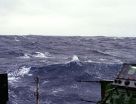(Press-News.org) A brand-new bacterial species has been found aboard the RMS Titanic, which is contributing to its deterioration. The discovery reveals a potential new microbial threat to the exterior of ships and underwater metal structures such as oil rigs.
The researchers, who report their findings in the latest issue of the International Journal of Systematic and Evolutionary Microbiology published on 8 December, isolated the micro-organisms from a 'rusticle', collected from the RMS Titanic, 3.8 km below the ocean surface.
The novel bacterium has been named Halomonas titanicae by the scientists from Dalhousie University, Halifax, Canada and the University of Sevilla, Sevilla, Spain. The team also tested the rusting ability of the bacterium - and found that it was able to adhere to steel surfaces, creating knob-like mounds of corrosion products, which they will be reporting in an upcoming paper.
A similar bacterial corrosive process is thought to be responsible for the formation of the rusticles – which resemble rusty icicles – that adorn the hull of the RMS Titanic. While these appear to be solid structures, rusticles are highly porous and support a complex variety of bacteria, suggesting that H. titanicae may work in conjunction with other organisms to speed up the corrosion of the metal.
The RMS Titanic was made up of 50,000 tons of iron and has been progressively deteriorating for the past 98 years. Lead researchers Dr Bhavleen Kaur and Dr Henrietta Mann, from Dalhousie University explained that the role of microbes in this process is now starting to be understood. "We believe H. titanicae plays a part in the recycling of iron structures at certain depths. This could be useful in the disposal of old naval and merchant ships and oil rigs that have been cleaned of toxins and oil-based products and then sunk in the deep ocean."
Dr Kaur and Dr Mann believe that the findings have opened up further areas of research that could have applications for industry. "We don't know yet whether this species arrived aboard the RMS Titanic before or after it sank. We also don't know if these bacteria cause similar damage to offshore oil and gas pipelines," they said. "Finding answers to these questions will not only better our understanding of our oceans, but may also equip us to devise coatings that can prevent similar deterioration to other metal structures."
INFORMATION:
New microscopic life aboard the RMS Titanic
2010-12-07
ELSE PRESS RELEASES FROM THIS DATE:
The worm that turned on heavy metal
2010-12-07
Researchers in South America have studied the viability of using earthworms to process hazardous material containing high concentrations of heavy metal for the bioremediation of old industrial sites, landfill and other potentially hazardous areas. They provide details of a possible approach in the International Journal of Global Environmental Issues this month.
After pollinating insects, worms are probably the gardener's best friend and they have been encouraged to process garden waste and soil for generations. The common earthworm, Eisenia fetida, could also become a ...
Measuring air-sea exchange of carbon dioxide in the open ocean
2010-12-07
A team led by scientists at the United Kingdom's National Oceanography Centre have measured the air-sea exchange of carbon dioxide in the open ocean at higher wind speed then anyone else has ever managed. Their findings are important for understanding how interactions between the oceans and the atmosphere influence climate.
"Evaluating the factors influencing the transfer of gases such as carbon dioxide between the atmosphere and the ocean is needed for a full understanding of Earth's climate system," explained researcher John Prytherch of the National Oceanography Centre.
The ...
Virginia Tech, Carilion team with physician to create digital ER pediatric response chart
2010-12-07
A well-known paper-based medical chart used by pediatric emergency personnel across America is undergoing a 21st century boost in an collaborative effort between Virginia Tech's College of Engineering, Roanoke-based Carilion Clinic Children's Hospital, and the physician who created the original method some 25 years ago.
The Broselow Pediatric Emergency Tape – otherwise known as the Broselow Tape -- has been a staple of ERs and child trauma units for nearly three decades. Created by Hickory, N.C.-based physician James Broselow, the Broselow Tape is a long, durable tape ...
Warring Greeks find peace in ancient Egypt
2010-12-07
Tel Aviv ― Naukrtis, a Greek trade emporium on Egyptian soil, has long captured the imagination of archaeologists and historians. Not only is the presence of a Greek trading settlement in Egypt during the 7th and 6th century B.C.E. surprising, but the Greeks that lived there in harmony hailed from several Greek states which traditionally warred amongst themselves.
Dr. Alexander Fantalkin of Tel Aviv University's Department of Archaeology is delving deeper into this unique piece of ancient history to come up with a new explanation for how Naukrtis developed, and ...
Eutrophication makes toxic cyanobacteria more toxic
2010-12-07
Continued eutrophication of the Baltic Sea, combined with an ever thinner ozone layer, is favouring the toxic cyanobacterium Nodularia spumigena, reveals research from the University of Gothenburg, Sweden.
"There are several species of cyanobacteria, or blue-green algae, that can form surface blooms in the Baltic Sea," explains Malin Mohlin from the University of Gothenburg's Department of Marine Ecology. "Which species ends up dominating a bloom depends partly on how they deal with an increased amount of UV light and a shortage of nutrients. Nodularia spumigena is most ...
Exposure to mobile phones before and after birth linked to kids' behavioral problems
2010-12-07
Pregnant mums who regularly use mobile phones may be more likely to have kids with behavioural problems, particularly if those children start using mobile phones early themselves, suggests research published online in the Journal of Epidemiology and Community Health.
The researchers base their findings on more than 28,000 seven year olds and their mothers who were part of the Danish National Birth Cohort (DNBC) study.
This study enrolled nearly 100,000 pregnant women between 1996 and 2002, with the intention of tracking their kids' long term health.
The mums supplied ...
Ban electronic cigarettes until safety concerns are addressed, say researchers
2010-12-07
Regulatory authorities should consider banning electronic cigarettes until safety concerns have been addressed, concludes research published online in Tobacco Control.
The researchers base their conclusions on an evaluation of six different brands of electronic nicotine delivery systems or ENDS. These are not tobacco products, but are designed to look and feel like regular cigarettes.
They are aimed at smokers for use in places where cigarette smoking is not permitted as they don't produce smoke. They usually consist of a battery, an atomiser, and a replaceable cartridge ...
Flu vaccination disparities exacerbated by supply problems
2010-12-07
The gap in flu vaccination rates between elderly whites, African-Americans and Hispanics is amplified when vaccine supply is limited or delayed. That is the conclusion of a study out today in the American Journal of Preventive Medicine.
The study found that disparities in seasonal influenza vaccination rates between the groups grew by as much as 7 percentage points in years when there were problems with vaccine supply. By contrast, the gap narrowed by as much as 11 percentage points during years when the supply was more timely and abundant.
"There is a strong ...
Shy trout size it up
2010-12-07
Personality is not just a feature unique to humans and pets. Scientists at the University of Gothenburg (Sweden) have revealed that also brown trout have individual characters and show different personalities.
Researcher Bart Adriaenssens from the Department of Zoology at the University of Gothenburg has for many years studied the behaviour of juvenile trout from watercourses on the west coast of Sweden.
"My results show that it are not just humans and other mammals that exhibit personality. Also brown trout differ among each other in their level of aggression and react ...
2 studies provide insight into stroke risk and prevention in young sickle cell anemia patients
2010-12-07
Monthly blood transfusions combined with daily medication to remove the resulting excess iron remains the best approach for reducing the risk of recurrent strokes in young patients with sickle cell anemia, according to a preliminary analysis of a multicenter trial that includes St. Jude Children's Research Hospital.
The study compared the efficacy of two treatments for the potentially life-threatening problem of iron overload caused by chronic transfusion therapy. The transfusions are used to guard against additional strokes in young sickle cell anemia patients. The trial, ...




